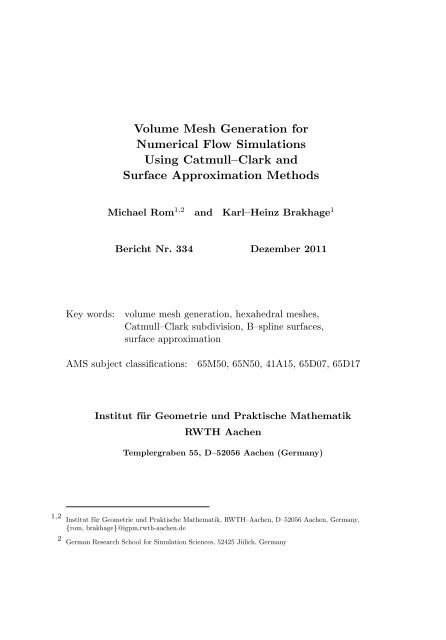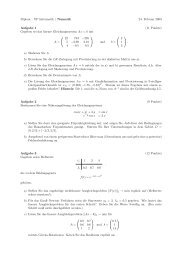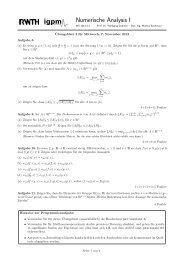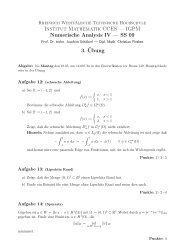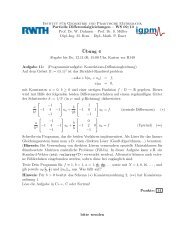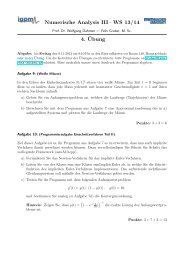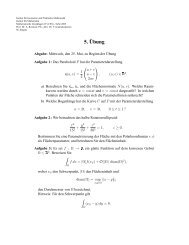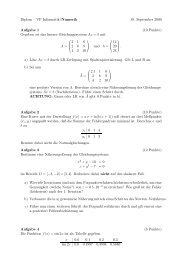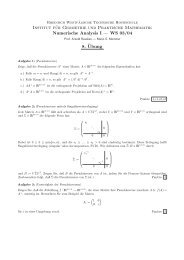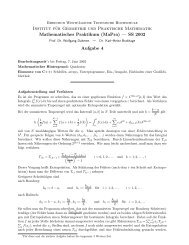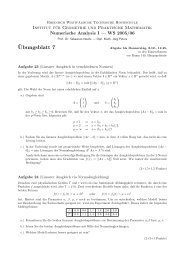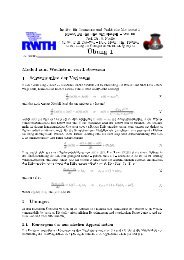Volume Mesh Generation for Numerical Flow Simulations Using ...
Volume Mesh Generation for Numerical Flow Simulations Using ...
Volume Mesh Generation for Numerical Flow Simulations Using ...
You also want an ePaper? Increase the reach of your titles
YUMPU automatically turns print PDFs into web optimized ePapers that Google loves.
<strong>Volume</strong> <strong>Mesh</strong> <strong>Generation</strong> <strong>for</strong><br />
<strong>Numerical</strong> <strong>Flow</strong> <strong>Simulations</strong><br />
<strong>Using</strong> Catmull–Clark and<br />
Surface Approximation Methods<br />
Michael Rom 1,2 and Karl–Heinz Brakhage 1<br />
Bericht Nr. 334 Dezember 2011<br />
Key words:<br />
volume mesh generation, hexahedral meshes,<br />
Catmull–Clark subdivision, B–spline surfaces,<br />
surface approximation<br />
AMS subject classifications:<br />
65M50, 65N50, 41A15, 65D07, 65D17<br />
Institut für Geometrie und Praktische Mathematik<br />
RWTH Aachen<br />
Templergraben 55, D–52056 Aachen (Germany)<br />
1,2 Institut für Geometrie und Praktische Mathematik, RWTH–Aachen, D–52056 Aachen, Germany,<br />
{rom, brakhage}@igpm.rwth-aachen.de<br />
2 German Research School <strong>for</strong> Simulation Sciences, 52425 Jülich, Germany
<strong>Volume</strong> <strong>Mesh</strong> <strong>Generation</strong> <strong>for</strong> <strong>Numerical</strong> <strong>Flow</strong><br />
<strong>Simulations</strong> using Catmull-Clark and Surface<br />
Approximation Methods<br />
Michael Rom 1,2 and Karl-Heinz Brakhage 1<br />
1 Institut für Geometrie und Praktische Mathematik, RWTH Aachen,<br />
52056 Aachen, Germany, {rom,brakhage}@igpm.rwth-aachen.de<br />
2 German Research School <strong>for</strong> Simulation Sciences, 52425 Jülich, Germany<br />
Summary. In this paper we present a new technique <strong>for</strong> the semi-automatic generation<br />
of volume meshes which can be used <strong>for</strong> numerical simulations of flows around<br />
given geometries. Our aim is to end up with a high-quality block-structured volume<br />
mesh connected to a smooth surface mesh. For this purpose we start with a polyhedron<br />
giving a rough approximation of the target surface geometry which can be of<br />
arbitrary genus. To this initial polyhedron we apply an alternating iterative process<br />
of Catmull-Clark subdivisions and approximations of the target surface. Usually,<br />
such a surface is given by a collection of trimmed B-spline surfaces. Hence, the<br />
best approximation results can be achieved by projecting the points of the Catmull-<br />
Clark limit surface, which converges to uni<strong>for</strong>m bi-cubic B-spline patches, onto it<br />
and subsequently recomputing the control mesh. If we construct another polyhedron<br />
surrounding the initial polyhedron, both being automatically connected to<br />
each other, we can per<strong>for</strong>m three-dimensional Catmull-Clark subdivision to the flow<br />
field between the inner and the outer surface.<br />
1 Introduction, Significance and Related Work<br />
<strong>Numerical</strong> flow simulations require high-quality volume meshes. The generation<br />
of such meshes as well as the construction of the object around or through<br />
which the flow should be simulated can be very difficult and time-consuming.<br />
We have developed a new promising approach by combining established methods<br />
<strong>for</strong> 2D- and 3D-subdivision with new or adapted algorithms <strong>for</strong> the computation<br />
of the limit points of a subdivision surface, the projection of these<br />
limit points onto given B-spline surfaces and the approximation of these given<br />
surfaces to get new surface mesh control points (= vertices).<br />
The overall process is illustrated in Fig. 1. The user only has to construct<br />
a simple inner initial surface polyhedron, being roughly similar to the target<br />
surface of arbitrary genus, and an outer surrounding polyhedron by giving<br />
the coordinates, the face connectivity and optionally edges which should be
2 Michael Rom and Karl-Heinz Brakhage<br />
Fig. 1. Process of volume mesh generation<br />
treated like creases. These two surfaces are connected automatically leading to<br />
a coarse volume mesh representing the flow field. This initial semi-automatic<br />
step is illustrated <strong>for</strong> a simple wing with an open end <strong>for</strong> the attachment of a<br />
fuselage in Fig. 2.<br />
The subsequent iterative process can be stopped if the approximation of<br />
the target surface is satisfying. If necessary, a more uni<strong>for</strong>m distribution of<br />
mesh control points can be obtained by applying smoothing steps after an<br />
approximation step in each iteration. The mesh resulting from the overall<br />
process depicted in Fig. 1 can be converted to a B-spline volume mesh. Hence,<br />
it is possible to apply further grid refinement by spline evaluation.<br />
Figure 3 gives a 1D-example of the iterative process by showing a fragment<br />
of a polygon: P 0 is a vertex of this control polygon. One subdivision (iteration<br />
step 1) leads to a new position of that vertex (Q 0 ) and a refinement of the<br />
control polygon by inserting edge points (which are not drawn in the picture).<br />
The point on the limit curve corresponding to P 0 can be calculated and is<br />
denoted by L 0 (iteration step 2). If this is projected to a given target curve<br />
we obtain L p (iteration step 3). To <strong>for</strong>ce our limit curve to pass through L p<br />
or at least to lie close to it, we have to replace Q 0 by Q 1 . This calculation<br />
is done by a least squares approximation (iteration step 4). Repeating the<br />
overall process results in an accurate approximation of the target curve along<br />
with a consequent refinement of control points.<br />
Fig. 2. Semi-automatic construction of an initial mesh (1: simple polyhedron as a<br />
starting point <strong>for</strong> the volume mesh generation, 2: surrounding polyhedron around the<br />
initial one, 3: edge and face connections between the inner and the outer polyhedron,<br />
translucent view)
Catmull-Clark <strong>Volume</strong> <strong>Mesh</strong>ing 3<br />
Fig. 3. Example <strong>for</strong> the workflow in the case of a curve (0: initial control polygon,<br />
1: control polygon after one subdivision, 2: limit curve of the subdivision process,<br />
3: given target curve, 4: new control polygon after approximation of the target curve)<br />
For the 2D-subdivisions of the inner and the outer surface, which are<br />
applied simultaneously to the 3D-subdivision of the space in between, we use<br />
the scheme presented by Catmull and Clark [1] which is applicable to surfaces<br />
of arbitrary genus. Due to the convergence of the Catmull-Clark limit surface<br />
to uni<strong>for</strong>m bi-cubic B-spline patches (see [1]) we get a smooth C 2 -surface with<br />
the exception of points where no tensor-product topology is given (C 1 there).<br />
The results of Stam’s analysis of the subdivision matrix [2] with an extension<br />
<strong>for</strong> modeling creases by de Rose et al. [3] allow <strong>for</strong> the pre-calculation of the<br />
limit points of the inner surface at each refinement level. The limit points can<br />
then be used <strong>for</strong> the approximation of a given target surface. In our practical<br />
applications these target surfaces are often given as trimmed B-spline surfaces.<br />
The Nelder-Mead optimization algorithm [4] is used <strong>for</strong> the projection of the<br />
limit surface onto such a B-spline surface.<br />
The space between the inner and the outer surface is the flow field and<br />
has to be refined successively. Thus, we need an extension of the Catmull-<br />
Clark subdivision rules to volume meshes. The first scheme <strong>for</strong> that purpose<br />
was presented by Joy and MacCracken [5] as a direct generalization of the<br />
two-dimensional subdivision rules. The analysis of the rules in matters of the<br />
smoothness of the resulting volume mesh is very difficult. Hence, Bajaj et<br />
al. [6] tried another approach: They factored the tri-cubic subdivision process<br />
into tri-linear subdivision followed by averaging, overall leading to rules which<br />
are easier to understand. We apply 3D-subdivision by using a combination of<br />
these two schemes.<br />
The rest of the paper is structured as follows: Section 2 gives an overview<br />
of the Catmull-Clark subdivision rules <strong>for</strong> surfaces and volumes and describes<br />
why the Catmull-Clark scheme is the method of choice <strong>for</strong> our purpose. In
4 Michael Rom and Karl-Heinz Brakhage<br />
Sect. 3 we briefly explain how the points of the limit surface can be calculated<br />
and demonstrate how they are used <strong>for</strong> the approximation of target surfaces<br />
given by a B-spline representation. Section 4 describes a non-shrinking mesh<br />
smoothing algorithm which can be applied after an approximation to obtain<br />
a more uni<strong>for</strong>m distribution of mesh control points.<br />
2 Background on Catmull-Clark Subdivision<br />
In iteration step 1 of our mesh generation process (see Fig. 1) two-dimensional<br />
Catmull-Clark subdivision [1] is applied to the inner and to the outer surface,<br />
while the space in between is refined by using derived rules <strong>for</strong> threedimensional<br />
subdivision.<br />
2D-Subdivision<br />
Catmull and Clark published their descriptions of quadratic and cubic subdivision<br />
surfaces in 1978. Contrary to tensor-product splines, this scheme can<br />
be applied to meshes that are not regular rectangular grids. A refinement step<br />
is defined by the following rules:<br />
1. For each face add a point given by the average of the N face vertices:<br />
F = 1 N<br />
N−1<br />
∑<br />
2. For each edge add a point given by a weighted average of the two new<br />
adjacent face points F left , F right and the edge midpoint E c :<br />
i=0<br />
P i<br />
E = 1 4 (F left + 2E c + F right )<br />
3. Move each old vertex to a new position given by a weighted average of the<br />
vertex P, the average ˜F of the new adjacent face points and the average<br />
Ẽ c of the adjacent edge midpoints:<br />
P new = 1 N (˜F + 2Ẽc + (N − 3)P)<br />
N denotes the valence of P, i.e., the number of edges connected to P.<br />
Figure 4 shows three fragments of a mesh representing these three refinement<br />
rules of one Catmull-Clark subdivision. The weights given <strong>for</strong> the vertices and<br />
face points directly result from the rules. Finally, the new edges are built by<br />
splitting the old ones and connecting the new face points to the new adjacent<br />
edge points. The new faces are the faces inside the old ones.
Catmull-Clark <strong>Volume</strong> <strong>Mesh</strong>ing 5<br />
Fig. 4. Illustration of the subdivision rules <strong>for</strong> the Catmull-Clark method, from left<br />
to right: insertion of a new face point, insertion of a new edge point, computation<br />
of a new vertex position<br />
Applying the subdivision rules to a mesh of quadrilaterals we obtain a<br />
refined mesh at the new subdivision level l + 1 with the following numbers of<br />
faces (#F ), edges (#E) and vertices (#V ):<br />
#F l+1 = 4 #F l<br />
#E l+1 = 4 #F l + 2 #E l<br />
#V l+1 = #F l + #E l + #V l<br />
In our modeling and grid generation concepts (see [7]) we want to end<br />
up with smooth untrimmed B-spline patches. These can be provided by an<br />
easy implementable conversion of the Catmull-Clark limit surface. Thus, this<br />
scheme is the method of choice. We summarize its crucial properties (cf. [8]):<br />
• The surfaces can be of arbitrary genus since the subdivision rules can be<br />
carried out to a mesh of arbitrary topological type.<br />
• After one subdivision all faces are quadrilaterals.<br />
• Except at extraordinary vertices (vertices of valence N ≠ 4) the limit<br />
surface converges to uni<strong>for</strong>m bi-cubic B-spline patches. Hence, the surface<br />
is C 2 -continuous except at extraordinary vertices.<br />
• Near an extraordinary vertex the surface can be shown to have a well defined<br />
tangent plane at the limit point, but the curvature there is generally<br />
not well defined.<br />
• The number of extraordinary vertices is fixed after the first subdivision,<br />
so that less smooth regions are scaled down with each further subdivision<br />
(see Sect. 3 and Fig. 7 <strong>for</strong> more details).<br />
• After two subdivisions each face can contain one extraordinary vertex at<br />
most. This allows us to easily compute the points of the Catmull-Clark<br />
limit surface, see Sect. 3.<br />
• The subdivision rules can be modified in such a way that they generate<br />
infinitely sharp creases as well as semi-sharp creases, i.e., creases <strong>for</strong> which
6 Michael Rom and Karl-Heinz Brakhage<br />
the sharpness can vary from zero (meaning smooth) to infinite, see de Rose<br />
et al. [3] <strong>for</strong> more details. An example <strong>for</strong> a situation in which we need the<br />
possibility of modeling creases is the connection of a wing to a fuselage<br />
which should not be smoothed during a subdivision process.<br />
Example<br />
Figure 5 gives an example <strong>for</strong> the application of the Catmull-Clark subdivision<br />
scheme. Despite using a rough approximation of a wing as an initial mesh, we<br />
end up with a smooth mesh of high quality after only a few subdivisions (in<br />
this case three).<br />
Fig. 5. Initial polyhedron <strong>for</strong> the Catmull-Clark method (top) and polyhedron after<br />
three subdivisions (bottom)<br />
3D-Subdivision<br />
For three-dimensional subdivision we use the rules given in the list below<br />
demanding the volume mesh to contain only hexahedra composed of eight<br />
vertices, six faces and twelve edges. This is guaranteed if the inner surface<br />
mesh exclusively consists of quadrilaterals be<strong>for</strong>e connecting it to the outer<br />
one. Since the first Catmull-Clark subdivision always provides a quadrilateral<br />
mesh, this requirement can be fulfilled easily.
The following rules are used:<br />
Catmull-Clark <strong>Volume</strong> <strong>Mesh</strong>ing 7<br />
1. For each volumetric cell add a point given by the average of the eight cell<br />
vertices:<br />
C = 1 7∑<br />
P i<br />
8<br />
2. For each face add a point given by a weighted average of the two new<br />
adjacent cell points C left , C right and the face centroid F c :<br />
i=0<br />
F = 1 4 (C left + 2F c + C right )<br />
3. For each edge add a point given by a weighted average of the edge midpoint<br />
E c where N denotes the number of adjacent faces, the average ˜C of the<br />
new adjacent cell points and the average ˜F c of the adjacent face centroids:<br />
E = 1 N ( ˜C + 2˜F c + (N − 3)E c )<br />
4. Move each old vertex to a new position:<br />
P new =<br />
∑<br />
U i ∈ ring(P)<br />
3 3−dim(Ui,P)<br />
4 3 val(P)<br />
val(U i , P) U i<br />
with ring(P) denoting the set of vertices U i connected to P by a cell, a<br />
face or an edge. The vertex P itself is stored in ring(P), too. val(P) is<br />
the number of cells containing P, whereas val(U i , P) gives the number<br />
of cells containing both U i and P. dim(U i , P) specifies the connection<br />
between U i and P (0 if U i = P, 1 if U i and P lie on a common edge, 2<br />
if they only lie on a common face or 3 if they only lie on a common cell).<br />
The first three of these 3D-rules were presented by Joy and MacCracken [5]<br />
in 1996. Since their vertex recomputation <strong>for</strong>mula (rule 4) does not consider<br />
an adjustment <strong>for</strong> the number of edges a vertex is connected to, we use the<br />
equation published by Bajaj et al. [6] in 2002 instead.<br />
Finally, the new edges are built by splitting the old ones, connecting the<br />
new face points to the new adjacent edge points and connecting the new cell<br />
points to the new adjacent face points. The new faces are the faces inside<br />
the old ones and inside the old cells. The new cells are the cells inside the<br />
old ones. Similar to the surface case we can define special edges (creases) and<br />
special faces to which the subdivision coefficients <strong>for</strong> curves and <strong>for</strong> surfaces<br />
are applied, respectively.<br />
Since our volume meshes consist of hexahedra only (see above), each subdivision<br />
leads to the following numbers of cells (#C), faces (#F ), edges (#E)<br />
and vertices (#V ) at the new subdivision level l + 1:
8 Michael Rom and Karl-Heinz Brakhage<br />
#C l+1 = 8 #C l<br />
#F l+1 = 12 #C l + 4 #F l<br />
#E l+1 = 6 #C l + 4 #F l + 2 #E l<br />
#V l+1 = #C l + #F l + #E l + #V l<br />
Example<br />
An example <strong>for</strong> three-dimensional subdivision is given in Fig. 6. The coarse<br />
volume mesh in the right of Fig. 2 (mesh 3) has been subdivided twice treating<br />
the outer surface vertices as fixed and the outer surface edges as creases.<br />
Fig. 6. Example <strong>for</strong> three-dimensional subdivision (translucent view)<br />
3 Limit Points of Catmull-Clark Subdivision Surfaces,<br />
Projection onto B-Spline Surfaces and Approximation<br />
Stam [2] gave an algorithm <strong>for</strong> evaluating the Catmull-Clark scheme and its<br />
derivatives at arbitrary points. He used a choice of ordering <strong>for</strong> the control vertices<br />
such that the main part of the subdivision matrix has a cyclical structure.<br />
Hence, the discrete Fourier trans<strong>for</strong>m can be used to compute its eigenstructure.<br />
For the modified rules given in [3] this analysis is very technical, details<br />
of the investigation and the implementation can be found in [9].
Catmull-Clark <strong>Volume</strong> <strong>Mesh</strong>ing 9<br />
Fig. 7. Behavior near an extraordinary vertex of valence N = 3<br />
Due to the existence of extraordinary points a surface mesh cannot be<br />
evaluated everywhere at each subdivision level by well-known B-spline algorithms<br />
because the control vertex structure near an extraordinary point is not<br />
a simple rectangular grid. Thus, all faces that contain extraordinary vertices<br />
cannot be evaluated as uni<strong>for</strong>m B-splines. For our mesh we assume that each<br />
face is a quadrilateral and contains one extraordinary vertex at most, which<br />
both is fulfilled after two subdivisions at the latest. Figure 7 shows that the<br />
region in which the surface cannot be evaluated with standard methods is<br />
scaled down with every subdivision.<br />
Since we can evaluate the surface away from extraordinary vertices as a<br />
regular bi-cubic B-spline, the remaining problem is to demonstrate how to<br />
evaluate a patch corresponding to a face with just one extraordinary vertex,<br />
such as the dark region shown in Fig. 7. We introduce parameter values and<br />
define a surface patch x(u, v) over the unit square [0, 1] × [0, 1] such that the<br />
point x(0, 0) corresponds to the extraordinary vertex. We can evaluate the<br />
surface at such a vertex (x(0, 0)) as a linear combination of the circumfluent<br />
vertices. Additionally, we can evaluate x(u, 1) <strong>for</strong> u ∈ [0, 1] and x(1, v) <strong>for</strong><br />
v ∈ [0, 1] as regular B-spline part. The remaining problem is the evaluation<br />
x(u, v) in the rest of the unit square. This problem is solved by doing just<br />
enough subdivisions such that (u, v) corresponds to a regular part at that<br />
stage to do the evaluation as a regular bi-cubic B-spline.<br />
Limit Points<br />
A point L i of the Catmull-Clark limit surface corresponding to a mesh control<br />
point P (k)<br />
i of the current subdivision level k is defined by<br />
L i = lim<br />
k→∞ P(k) i ,<br />
i.e., the position after k → ∞ subdivisions. For the approximation of given<br />
surfaces with our Catmull-Clark meshes we can pre-compute the values L i<br />
of the limit surface (see iteration step 2 in Fig. 1) by using Stam’s abovementioned<br />
algorithm <strong>for</strong> evaluating the Catmull-Clark scheme at arbitrary<br />
points. For each face we compute nine limit points: four corresponding to the<br />
face vertices, four corresponding to the edges and one corresponding to the
10 Michael Rom and Karl-Heinz Brakhage<br />
Fig. 8. Example <strong>for</strong> the computation of the nine limit points <strong>for</strong> a face with one<br />
extraordinary vertex (number 0), left: six limit points can be calculated immediately,<br />
right: the remaining three limit points can be calculated after one subdivision<br />
face. An example is given in Fig. 8 where the vertex with the number 0 represents<br />
an extraordinary vertex. The six limit points <strong>for</strong> the vertices marked<br />
in the left part of the picture can be calculated immediately, since they belong<br />
to x(0, 0), x(u, 1) <strong>for</strong> u ∈ [0, 1] or x(1, v) <strong>for</strong> v ∈ [0, 1], see above. The<br />
computation of the remaining three limit points requires one subdivision of<br />
the mesh, so that the new vertices with the numbers 3 1 , 4 1 and 5 1 belong to<br />
x(u, 1) <strong>for</strong> u ∈ [0, 1] or x(1, v) <strong>for</strong> v ∈ [0, 1] at the new refinement level. All<br />
these computations can be applied without explicitly subdividing and lead<br />
to coefficients <strong>for</strong> each vertex participating in the limit point computation.<br />
Hence, the limit points L i can be written as a linear combination<br />
L i = c T i V i<br />
where we have collected the weights c j of the involved vertices P (k)<br />
j in the<br />
vicinity of the control point P (k)<br />
i in the vector c i and the associated vertices<br />
in V i . Details of the computation of the coefficients c j and the choice<br />
of the associated vertices P (k)<br />
j can be found in [9]. The vertex and edge limit<br />
P (k)<br />
j<br />
points are only calculated if they have not already been computed by considering<br />
an adjacent face be<strong>for</strong>e. Overall this leads to #V l + #F l + #E l limit<br />
points at the current subdivision level l. If a control point belongs to a special<br />
edge, i.e. a crease, we need other rules <strong>for</strong> the evaluation. There<strong>for</strong>e, we use<br />
our extension [9] in these cases.<br />
Projection<br />
For a given surface s we can project L i onto it: L i → L s i (iteration step 3 in<br />
Fig. 1). Usually, the surface s is given by a B-spline representation defined by<br />
x(u, v) =<br />
m∑<br />
r=0 s=0<br />
n∑<br />
x r,s N r,p (u)N s,q (v)<br />
(⋆)
Catmull-Clark <strong>Volume</strong> <strong>Mesh</strong>ing 11<br />
where (m + 1) × (n + 1) gives the number of control points and p and q denote<br />
the degree of the B-spline basis functions N r,p (u) and N s,q (v), respectively.<br />
Together with knot vectors in u- and v-direction, which have been omitted<br />
in (⋆), we can evaluate x(u, v) and the partial derivatives x u (u, v) and x v (u, v)<br />
by applying de Boor’s algorithm [10]. Given such a representation, we search<br />
<strong>for</strong> parameter values u Li and v Li <strong>for</strong> each limit point L i such that<br />
‖x(u Li , v Li ) − L i ‖ 2 = min<br />
u,v ‖x(u, v) − L i‖ 2 .<br />
We use the Nelder-Mead algorithm [4] to solve this distance minimization<br />
problem. This optimization algorithm is simple to understand and to implement,<br />
does not need any derivatives and is very robust. For each limit point<br />
a simplex, which in this two-dimensional case is a triangle in (u, v)-space, is<br />
built around the initial values (u 0 , v 0 ) which have to be set once prior to the<br />
first projection. Due to the robustness of the algorithm an inaccurate choice<br />
of initial values does not destroy the convergence of the algorithm. For each<br />
further projection we can calculate better initial values being closer to the<br />
resulting values: The limit points corresponding to vertices get the current<br />
(u, v)-values of the vertex as initial values, whereas the (u, v)-values <strong>for</strong> limit<br />
points corresponding to face or edge points are initialized by an average of<br />
the (u, v)-values of the particular adjacent vertices. In the first step of the<br />
Nelder-Mead algorithm the distances d j = ‖L i − x(u j , v j )‖ 2 , j = 0, 1, 2, of<br />
the limit point L i to the B-spline surface points x(u j , v j ) calculated <strong>for</strong> the<br />
triangle points y j = (u j , v j ) T are computed determining the best (b), the<br />
second-best (sb) and the worst (w) point of the triangle:<br />
d b = min<br />
j<br />
d j , d sb = min<br />
j≠b d j,<br />
d w = max d j , j = 0, 1, 2<br />
j<br />
The corresponding triangle points in are denoted by y b = (u b , v b ) T , y sb =<br />
(u sb , v sb ) T and y w = (u w , v w ) T , respectively. After that the midpoint<br />
y m = 1 ∑<br />
y j , j = 0, 1, 2<br />
2<br />
j≠w<br />
of the triangle edge opposite the worst point is computed. This leads to the<br />
reflection point<br />
y r = 2 y m − y w .<br />
Depending on the distance d r of x(u r , v r ) to the limit point the triangle is<br />
changed by applying the following rules:<br />
• If d r < d sb , replace y w by y r and restart the algorithm at the first step.<br />
• If d sb ≤ d r < d w , compute the contraction point<br />
y c = 1 2 (y m + y r ).
12 Michael Rom and Karl-Heinz Brakhage<br />
– If d c < d r , replace y w by y c and restart the algorithm at the first step.<br />
– If d c ≥ d r , per<strong>for</strong>m a shrinking trans<strong>for</strong>mation (see below).<br />
• If d r ≥ d w , compute the contraction point<br />
y c = 1 2 (y m + y w ).<br />
– If d c < d w , replace y w by y c and restart the algorithm at the first step.<br />
– If d c ≥ d w , per<strong>for</strong>m a shrinking trans<strong>for</strong>mation (see below).<br />
• Shrinking trans<strong>for</strong>mation: Compute two new points<br />
y 1 = 1 2 (y b + y sb ), y 2 = 1 2 (y b + y w )<br />
and replace y sb by y 1 and y w by y 2 . Restart the algorithm at the first<br />
step.<br />
The algorithm is terminated if the distance between the limit point and the<br />
B-spline surface point corresponding to the best triangle point is smaller than<br />
a threshold ε 1 or if the distance between the best and the worst triangle point<br />
is smaller than a threshold ε 2 , i.e., the area of the triangle is very small.<br />
Approximation<br />
Finally, we get an equation of the <strong>for</strong>m<br />
c T i V i !<br />
= L s i , L s i = x(u Li , v Li ).<br />
We use the notation CV ! = L s <strong>for</strong> the approximation problem<br />
‖CV − L s ‖ 2 → min<br />
and apply it <strong>for</strong> a single equation of this system, too. As described above,<br />
we have #V l + #F l + #E l limit points at the current subdivision level l and,<br />
consequentially, the same number of projection points. Hence, we end up with<br />
an over-determined sparse linear system <strong>for</strong> approximation (iteration step 4 in<br />
Fig. 1, Q 0 → Q 1 in Fig. 3) which we solve by applying the conjugate gradient<br />
method <strong>for</strong> linear least squares (CGLS or also called CGNR [11]), see below.<br />
Solving the approximation problem leads to new control point positions with<br />
better approximation properties <strong>for</strong> the next iteration loop.<br />
CGLS method<br />
Let A ∈ IR m×n with m ≥ n. It is well known that the solution <strong>for</strong> the linear<br />
least squares problem ‖Ax − b‖ 2 → min can be determined by solving the<br />
normal equations A T Ax = A T b. Furthermore, if rank(A) = n then A T A is<br />
symmetrical positive definite (spd). Un<strong>for</strong>tunately, in most cases A T A is badly
Catmull-Clark <strong>Volume</strong> <strong>Mesh</strong>ing 13<br />
conditioned and <strong>for</strong> a sparse A usually A T A is not sparse. The conjugate<br />
gradient method (CG) can be re<strong>for</strong>mulated to resolve both problems. We use<br />
two residual vectors r (k) = b − Ax (k) and s (k) = A T b − A T Ax (k) = A T r (k) .<br />
With this notation we can <strong>for</strong>mulate the CGLS-algorithm as follows:<br />
For A ∈ IR m×n with rank(A) = n and arbitrary initial vector x (0) :<br />
r (0) = b − Ax (0)<br />
s (0) = A T r (0)<br />
d (0) = s (0)<br />
<strong>for</strong> k = 0, 1, 2, ...<br />
α k = ‖s (k) ‖ 2 2 / ‖Ad (k) ‖ 2 2 // store Ad (k)<br />
x (k+1) = x (k) + α k d (k)<br />
r (k+1) = r (k) − α k Ad (k)<br />
s (k+1) = A T r (k+1)<br />
β k = ‖s (k+1) ‖ 2 2 / ‖s (k) ‖ 2 2<br />
d (k+1) = s (k+1) + β k d (k)<br />
until stop<br />
We stop if a maximum number of steps is exceeded (emergency exit) or the<br />
residual becomes smaller than a given tolerance ε, i.e., ‖s (k) ‖ 2 ≤ ε. Notice<br />
that the cost <strong>for</strong> one CGLS step is linear in the number of control points.<br />
Example<br />
The wing depicted in Fig. 9 is used <strong>for</strong> a test of our iterative process from<br />
Fig. 1. The target geometry which we want to approximate consists of two<br />
different B-spline representations: The wing with degree 3 in u- and degree<br />
1 in v-direction is continuously differentiable connected to a wing tip (see<br />
Fig. 10) with degree 3 in u- and degree 2 in v-direction. Figure 11 shows<br />
the initial polyhedron which has been constructed manually. The result of the<br />
alternating application of 2D-subdivision, limit point computation, projection<br />
and approximation can be seen in Fig. 12 <strong>for</strong> the whole wing after three process<br />
iterations, while Fig. 13 reveals a detailed view of the wing tip. The agreement<br />
Fig. 9. B-spline surface (wing + wing tip) with knot-isolines
14 Michael Rom and Karl-Heinz Brakhage<br />
of the given B-spline surface and the approximated surface mesh as well as<br />
the distribution of mesh points are fine. An even better distribution can be<br />
achieved by applying smoothing steps after an approximation as shown in<br />
Sect. 4.<br />
Fig. 10. B-spline surface (wing tip) with knot-isolines<br />
Fig. 11. Initial polyhedron <strong>for</strong> the approximation of the B-spline surface from Fig. 9<br />
Fig. 12. Surface mesh (wing + wing tip) after three process iterations
Catmull-Clark <strong>Volume</strong> <strong>Mesh</strong>ing 15<br />
Fig. 13. Surface mesh (close-up of wing tip) after three process iterations<br />
4 Smoothing<br />
We want to obtain a more uni<strong>for</strong>m distribution of mesh control points. There<strong>for</strong>e,<br />
we use a smoothing method which is non-shrinking because otherwise we<br />
would lose the approximation of the given surface geometry. For each regular<br />
control point P i of the mesh, i.e., each control point with valence N = 4, we<br />
search <strong>for</strong> two opposite adjacent control points P adj,1 and P adj,3 connected by<br />
edges and construct a parabola passing through these two opposite vertices<br />
and the control point itself. The first smoothing step is then applied by moving<br />
the control point P i along the parabola into the direction of the midpoint of<br />
the parabola. The second step uses the other direction, i.e., passing a parabola<br />
through the control point P i and its remaining two opposite neighbors P adj,2<br />
and P adj,4 and again moving into the direction of the midpoint of that new<br />
parabola. An example <strong>for</strong> the procedure is depicted in Fig. 14.<br />
The derivation of the computations needed <strong>for</strong> a smoothing step can be<br />
explained on the basis of Fig. 15. The equation <strong>for</strong> the planar parabola passing<br />
through the three points P adj,1 , P i and P adj,3 can be <strong>for</strong>mulated as<br />
P(ξ) = P adj,1 + ξ d (P adj,3 − P adj,1 ) + αξ(d − ξ)(P i − P m )<br />
where d is given by<br />
d = ‖P adj,3 − P adj,1 ‖ 2<br />
and α will be determined later. The point P m is defined by<br />
P m = P adj,1 + β(P adj,3 − P adj,1 ).<br />
If we insert this into the scalar product<br />
(P i − P m ) · (P adj,3 − P adj,1 ) = 0<br />
we obtain<br />
β = (P i − P adj,1 ) · (P adj,3 − P adj,1 )<br />
(P adj,3 − P adj,1 ) 2 .
16 Michael Rom and Karl-Heinz Brakhage<br />
Fig. 14. Smoothing by moving control points along parabolae<br />
Fig. 15. Setting <strong>for</strong> the computation of a planar parabola passing through three<br />
points
Catmull-Clark <strong>Volume</strong> <strong>Mesh</strong>ing 17<br />
Finally, we have to determine α in such a way that the parabola passes through<br />
P i = P(βd), leading to the equation<br />
P i = P adj,1 +β(P adj,3 −P adj,1 )+αβd 2 (1−β) (P i − P adj,1 − β(P adj,3 − P adj,1 ))<br />
which is equivalent to<br />
αβd 2 (1 − β) = 1 ⇔ α =<br />
1<br />
βd 2 (1 − β) .<br />
Now we can move P i into the direction of P ( 1<br />
2 d) .<br />
The method only works well if P adj,1 or P adj,3 do not lie too close to P i<br />
because the parabola may become very steep in that case. Moving the control<br />
point along such a steep parabola would increase the distance of that point<br />
from the mesh quickly. Hence, we constrain the method to values of β between<br />
0.3 and 0.7. If β is smaller than 0.3 we move P adj,1 away from P i on the line<br />
through P adj,1 and P adj,3 until β becomes equal to or greater than 0.3 defining<br />
the new artificial point ¯P adj,1 . Then the flattened parabola passing through<br />
¯P adj,1 , P i and P adj,3 is computed. Analagously, we move P adj,3 away from P i<br />
if β is greater than 0.7 and construct the artificial point ¯P adj,3 .<br />
Finally, the control point is moved into the direction of the point P ( 1<br />
2 d)<br />
by using a damping factor. A good choice has turned out to be<br />
( 3<br />
ξ =<br />
4 β + 1 d.<br />
8)<br />
If the control point currently considered (P i ) is an extraordinary vertex,<br />
i.e., having a valence of N ≠ 4 and thus not being connected to four adjacent<br />
vertices by edges, we have to use another smoothing method. If N = 3 we<br />
compute the plane through the three adjacent control points connected to P i<br />
by edges. Now we define a local coordinate system by using the unit vectors<br />
spanning the plane as x- and y-direction. Hence, the signed distance of a<br />
control point to the plane gives the z-coordinate. We then can fit an explicit<br />
surface<br />
z(x, y) = ax 2 + bxy + cy 2 + dx + ey + f (⋆ ⋆)<br />
to the control point P i and its six adjacent control points (the three connected<br />
by edges as mentioned above and another three only connected by faces).<br />
If we translate the plane such that P i lies in it we can choose P i to be<br />
the origin of the local coordinate system. Hence, f = 0 <strong>for</strong>ces the plane to<br />
pass through P i . The other five coefficients are computed by inserting the<br />
local coordinates of the six adjacent control points into (⋆ ⋆) and solving the<br />
resulting approximation problem via a QR-algorithm. The new position <strong>for</strong><br />
the control point P i finally is determined by taking the x- and y-values of<br />
the barycenter of the triangle defined by the three adjacent control points<br />
connected by edges and inserting them into the equation <strong>for</strong> the fitted surface<br />
to obtain a z-coordinate.
18 Michael Rom and Karl-Heinz Brakhage<br />
If N ≥ 5 the approach is similar: Instead of a plane we have to use a regression<br />
plane, since the control point P i in this case has five or more adjacent<br />
control points connected by edges. To these and to the remaining adjacent<br />
control points being only connected by faces (at least five) we fit the surface<br />
z(x, y) = ax 3 + bx 2 y + cxy 2 + dy 3 + ex 2 + fxy + gy 2 + hx + iy + j.<br />
Hence, we have to solve an approximation problem again.<br />
Example<br />
Figure 16 again shows a close-up of the approximated wing tip after the same<br />
number of iterations as in Fig. 13 without smoothing (top) and with two<br />
smoothing steps after each approximation (bottom) leading to a more uni<strong>for</strong>m<br />
distribution of mesh points.<br />
Fig. 16. Surface mesh (close-up of wing tip) after three process iterations, top:<br />
without smoothing, bottom: with two smoothing steps after each approximation<br />
5 Conclusion and Future Work<br />
We have presented a fast iterative procedure <strong>for</strong> the generation of high-quality<br />
block-structured volume meshes with an inner surface well con<strong>for</strong>ming to a<br />
given target surface. Apart from the manual generation of two initial polyhedra<br />
the whole process operates automatically. It uses modified Catmull-Clark<br />
surface subdivision rules to produce smooth surface meshes, extended by the<br />
possibility to model creases, and tensor-product Catmull-Clark volume subdivision<br />
rules <strong>for</strong> the refinement of the flow field between the inner and the
Catmull-Clark <strong>Volume</strong> <strong>Mesh</strong>ing 19<br />
outer surface. The points of the inner Catmull-Clark limit surface can be precomputed<br />
after each subdivision and then be projected onto a given B-spline<br />
surface by using the Nelder-Mead algorithm. New control points of the mesh<br />
can then be obtained by approximating the projected limit points. This linear<br />
least-squares problem is solved by applying the CGLS-method. After an<br />
approximation one or more smoothing steps can be applied to obtain a more<br />
uni<strong>for</strong>m distribution of mesh control points.<br />
We will evaluate the quality of our implementation by using the resulting<br />
volume meshes <strong>for</strong> numerical flow simulations as already done <strong>for</strong> simple geometries<br />
in [9]. From the sub-project High Reynolds Number Aero-Structural<br />
Dynamics (HIRENASD) of the SFB 401 <strong>Flow</strong> Modulation and Fluid-Structure<br />
Interaction at Airplane Wings at RWTH Aachen (see [12]) we have experimental<br />
data from wind tunnel readings <strong>for</strong> the wing in Fig. 9 attached to a<br />
simplified fuselage. Furthermore, from the follow-up project Aero-Structural<br />
Dynamics Methods <strong>for</strong> Airplane Design (ASDMAD) (see [13]), a cooperation<br />
with Airbus, we have additional experimental results <strong>for</strong> a wing with a winglet.<br />
We will compare the results <strong>for</strong> both configurations to the simulation results<br />
in order to have an indicator <strong>for</strong> the quality of the overall process.<br />
Acknowledgments<br />
The first author is funded by the German Research School <strong>for</strong> Simulation<br />
Sciences (GRS), Jülich, Germany.<br />
References<br />
1. J. Clark and E. Catmull. Recursively generated B-spline surfaces on arbitrary<br />
topological meshes. CAD, 10(6):350–355, 1978.<br />
2. J. Stam. Exact Evaluation of Catmull-Clark Subdivision Surfaces at Arbitrary<br />
Parameter Values. In Proceedings of SIGGRAPH, pages 395–404, 1998.<br />
3. T. DeRose, M. Kass, and T. Truong. Subdivision Surfaces in Character Animation.<br />
In Proceedings of the 25th annual conference on Computer graphics and<br />
interactive techniques, ACM SIGGRAPH, pages 85–94, 1998.<br />
4. J. A. Nelder and R. Mead. A simplex method <strong>for</strong> function minimization. Computer<br />
Journal, 7:308–313, 1965.<br />
5. K. Joy and R. MacCracken. The Refinement Rules <strong>for</strong> Catmull-Clark Solids.<br />
Technical Report CSE-96-1, Department of Computer Science, University of<br />
Cali<strong>for</strong>nia, Davis, 1996.<br />
6. C. Bajaj, S. Schaefer, J. Warren, and G. Xu. A subdivision scheme <strong>for</strong> hexahedral<br />
meshes. The Visual Computer, 18:343–356, 2002.<br />
7. K.-H. Brakhage and Ph. Lamby. Application of B-Spline Techniques to the<br />
Modeling of Airplane Wings and <strong>Numerical</strong> Grid <strong>Generation</strong>. CAGD, 25(9):738–<br />
750, 2008.
20 Michael Rom and Karl-Heinz Brakhage<br />
8. K. H. Brakhage. Modified Catmull-Clark Methods <strong>for</strong> Modelling, Reparameterization<br />
and Grid <strong>Generation</strong>. In Proceedings of the 2. Internationales Symposium<br />
Geometrisches Modellieren, Visualisieren und Bildverarbeitung, HfT Stuttgart,<br />
pages 109–114, 2007.<br />
9. M. Rom. Oberflächenreparametrisierung und Gittererzeugung für numerische<br />
Strömungssimulationen mit Hilfe von Catmull-Clark-Methoden. Diplomarbeit,<br />
RWTH Aachen, 2009.<br />
10. C. de Boor. A Practical Guide to Splines. Springer, 1978.<br />
11. Y. Saad. Iterative Methods <strong>for</strong> Sparse Linear Systems. SIAM, 2nd edition, 2003.<br />
12. W. Schröder, editor. Summary of <strong>Flow</strong> Modulation and Fluid-Structure Interaction<br />
Findings. Notes on <strong>Numerical</strong> Fluid Mechanics and Multidisciplinary<br />
Design, Vol. 109. Springer, 2010.<br />
13. J. Ballmann, A. Boucke, B.-H. Chen, L. Reimer, M. Behr, A. Dafnis, C. Buxel,<br />
S. Buesing, H.-G. Reimerdes, K.-H. Brakhage, H. Olivier, M. Kordt, J. Brink-<br />
Spalink, F. Theurich, and A. Büscher. Aero-Structural Wind Tunnel Experiments<br />
with Elastic Wing Models at High Reynolds Numbers (HIRENASD -<br />
ASDMAD). 49th AIAA Aerospace Sciences Meeting, Orlando, Florida, 2011.


